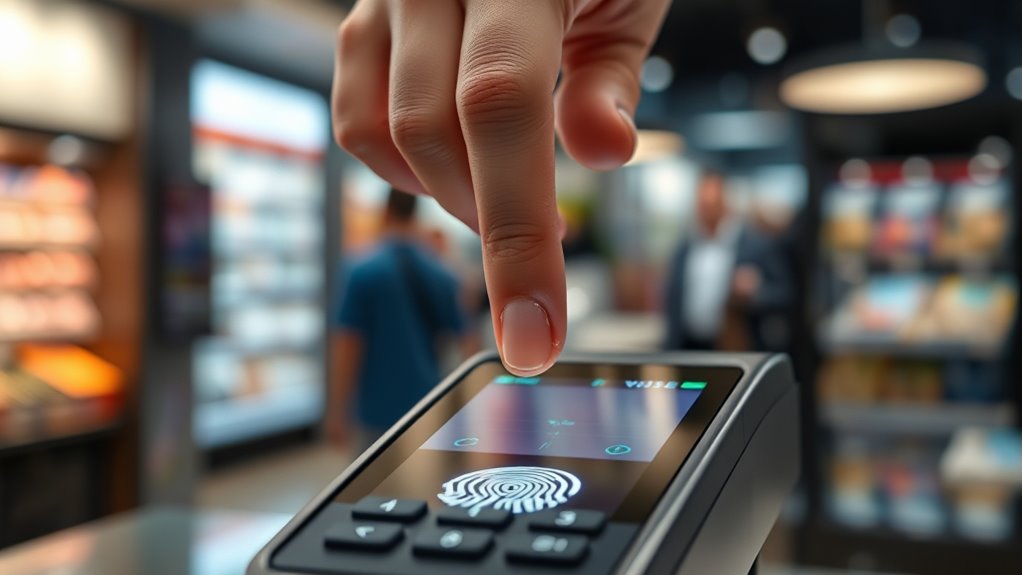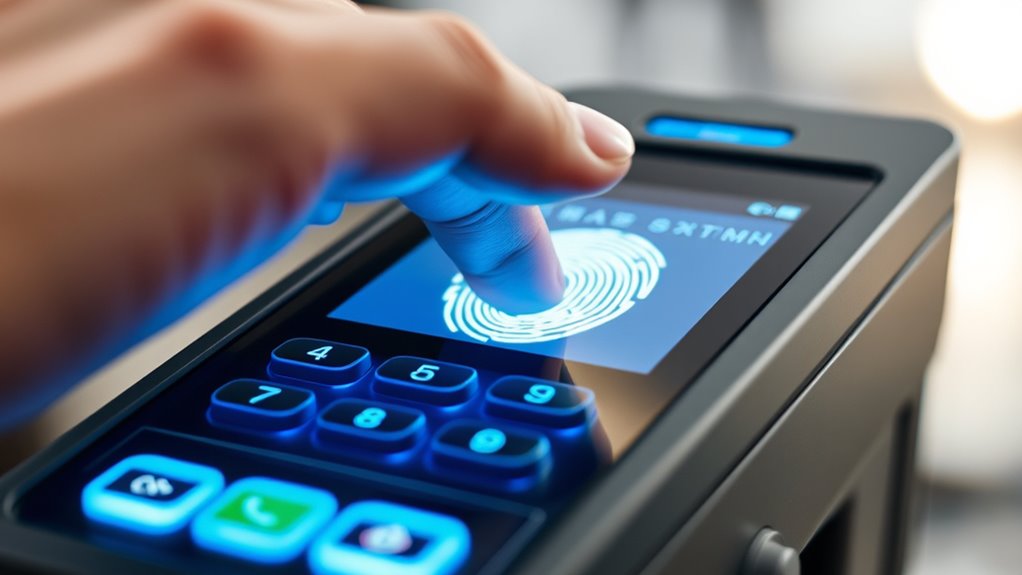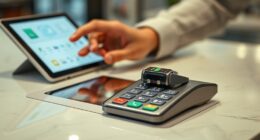Biometric payments are quickly replacing signatures by offering enhanced security and convenience. As contactless tech and smartphones become more common, you can authorize transactions with your fingerprint, face, or voice, reducing fraud risks. Many regions are adopting laws to protect biometric data, increasing trust. This shift means faster, safer payments that eliminate the need for signatures. Keep exploring to see how these innovations are shaping the future of transactions and what it means for you.
Key Takeaways
- Biometric payments offer a secure, contactless alternative to traditional signatures, reducing fraud risks.
- Growing consumer preference for quick, convenient transactions boosts biometric payment adoption.
- Advances in fingerprint, facial, and voice recognition improve accuracy and speed in payment processes.
- Regulations and data privacy laws foster trust and facilitate wider acceptance of biometric payment methods.
- Market projections indicate rapid expansion, with biometric payments expected to reach over $66 billion by 2029.

Have you noticed how biometric payments are transforming the way we handle transactions? It’s no longer just about swiping a card or signing receipts. Instead, you’re increasingly using your fingerprints, face, or even iris scans to verify purchases quickly and securely. This shift is driven by a combination of technological advancements and the need for better fraud prevention. The biometric payment market is booming, valued at around $46.61 billion in 2025 and projected to reach $66.74 billion by 2029, growing at a compound annual rate of 9.4%. Earlier, the market expanded from $42.86 billion in 2024 to $46.61 billion in 2025, with an 8.7% growth rate. Looking further ahead, some projections estimate the global biometric payment industry could hit $1.2 trillion by 2033, reflecting an extraordinary growth rate of 365% from 2022 to 2027. This rapid expansion indicates that biometric payments are becoming a mainstay in modern finance.
The key drivers behind this trend are clear. As cyber threats increase, traditional security measures like PINs and signatures no longer suffice. Biometric authentication offers a more secure way to confirm identities, reducing the risk of fraud and unauthorized access. Governments and regulators worldwide are supporting this shift by implementing laws that protect biometric data, encouraging both consumers and businesses to adopt these technologies. Consumers also favor the convenience biometric solutions provide. With biometric wearables and smartphones, you can authorize payments effortlessly, often without needing to carry cash or cards. The rise of e-commerce and contactless payments further accelerates this adoption, making transactions faster and more seamless.
Popular biometric modalities like fingerprint scans, facial recognition, and iris scans are now common in payment systems. Multi-modal biometrics, which combine multiple identifiers, improve accuracy and security. Continuous authentication methods, providing real-time identity verification, ensure you’re always protected, even during ongoing transactions. Voice and speech recognition are gaining popularity, especially for hands-free payments, and cross-channel authentication technologies enable seamless use across devices. Recent advancements in biometric sensors have significantly improved the speed and accuracy of these systems, making them more reliable for everyday use. Additionally, the integration of biometric data security practices is crucial to address privacy concerns and foster user trust.
Regionally, emerging markets in Asia-Pacific and Latin America present huge opportunities for biometric payment growth. In the U.S., over 75% of consumers have used biometric features like fingerprint or facial recognition for payments or security. Globally, the number of people using facial recognition for payments is expected to surpass 1.4 billion by 2025. Despite this progress, concerns about data privacy remain high—86% of people worry about how their biometric data is used, and many mistrust companies handling their information. Still, most countries have laws protecting biometric data, ensuring some level of security.
Banks and financial institutions adopting biometric authentication report significant fraud reductions—JPMorgan Chase, for example, saw a 20% decrease in fraud. These methods not only improve security but also maintain user convenience, helping balance the two in a modern payment landscape. Biometric payment cards and contactless solutions are reducing risks associated with traditional card fraud, making transactions safer. As biometric technology continues to evolve and integrate into smartphones and wearables, the way you pay is set to become faster, safer, and more intuitive—swipe left on signatures, indeed.
Frequently Asked Questions
How Secure Are Biometric Payment Methods Against Hacking?
You’re wondering how secure biometric payment methods are against hacking. They’re generally quite secure, reducing fraud by up to 75%, and systems like facial recognition and fingerprint authentication have high accuracy rates. But, no system is entirely foolproof. Sophisticated spoofing attacks, like deepfakes, pose risks. That’s why continuous innovation, anti-spoofing measures, and strict data privacy protocols are essential to keep your biometric data safe from hackers.
What Are the Privacy Concerns Surrounding Biometric Data?
You might think biometric data keeps your identity safe, but hidden risks lurk. Once hacked, your fingerprints or facial scans can’t be changed, leaving you permanently vulnerable. Surveillance fears grow as systems track you without consent, and inaccuracies might wrongly flag or deny you. Without clear laws or transparency, your personal details could be misused or exposed, turning your biometric info into a tool for intrusion rather than protection.
Which Countries Are Leading in Biometric Payment Adoption?
You’ll find North America leading in biometric payment adoption, accounting for 35% of global revenues in 2024. The US pushes this trend with major banks integrating biometric options, driven by fraud concerns and new regulations on data encryption. Asia-Pacific follows closely, especially China, India, and Japan, with widespread use in mobile wallets and kiosks. Europe also shows significant growth due to strong regulations, while emerging markets like Latin America and Africa are rapidly expanding access to financial services through biometric tech.
How Do Biometric Payments Compare Costs With Traditional Methods?
Think of biometric payments as the modern knight, battling high costs of fraud in traditional methods. You’ll find that biometrics reduce fraud, chargebacks, and security expenses, saving you money. Faster transactions boost efficiency, increasing sales without extra costs. Though initial setup can be pricey, long-term gains like lower fraud risks and improved customer trust outweigh the investment. Overall, biometric payments offer a smarter, cost-effective alternative to traditional payment methods.
Can Biometric Payments Work Offline Without Internet Access?
You might wonder if biometric payments can work offline without internet access. The answer is yes. Technologies like NFC, Bluetooth, and QR codes enable secure offline transactions. Your device stores cryptographic keys and payment credentials securely in Virtual Secure Elements, allowing you to pay without network connection. Payment terminals temporarily hold transaction data, syncing it once online. This setup ensures fast, reliable payments even in areas with poor or no internet connectivity.
Conclusion
As biometric payments become more widespread, you might wonder if cash or card will soon become obsolete. With faster, more secure transactions at your fingertips, it’s clear that the future of payments is here. Are you ready to embrace this seamless, swipe-left world? Staying ahead means trusting in technology that simplifies your life—so why not make the switch now? The next step in your payment journey is just a fingerprint away.









